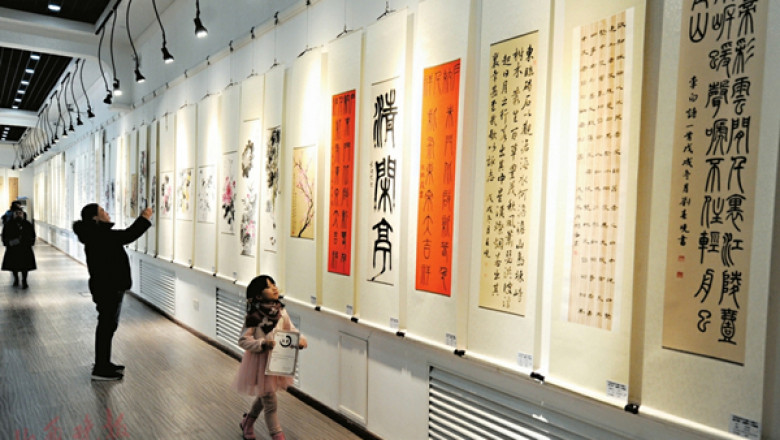views
Chinese art calligraphy is more than just writing—it's a profound expression of culture, emotion, and history. At China Art Hub, we delve deep into the brushstrokes, tools, traditions, and philosophies that define this ancient artistic discipline. If you’re a collector, artist, or simply a culture enthusiast, understanding Chinese calligraphy opens a new dimension into the heritage of China.
What Is Chinese Art Calligraphy?
Chinese calligraphy (書法, shūfǎ) refers to the artistic practice of writing Chinese characters using brush and ink. It is not only a visual art form but also a representation of the writer’s spirit, rhythm, and personality.
“Calligraphy reveals the character of a person.” – Ancient Chinese proverb
This practice has remained central to Chinese cultural identity for over 2,000 years. The way each character is written—its strokes, spacing, and structure—communicates more than just meaning.
Key Features of Traditional Chinese Calligraphy
| Element | Description |
|---|---|
| Brush Types | Soft or hard hair brushes made from animal fur |
| Ink Materials | Traditional ink made from soot and glue, ground with water |
| Paper & Silk | Xuan paper (rice paper) and silk used for calligraphy scrolls |
| Character Styles | Seal Script, Clerical Script, Regular Script, Running Script, Cursive Script |
| Tools (文房四寶) | The Four Treasures: Brush, Ink, Paper, and Inkstone |
Major Styles in Chinese Calligraphy
Chinese calligraphy includes five major script styles:
-
Seal Script (篆書): Earliest style used on bronze artifacts
-
Clerical Script (隸書): Used during the Han dynasty, flatter strokes
-
Regular Script (楷書): Most readable, standardized strokes
-
Running Script (行書): A semi-cursive, fluid style
-
Cursive Script (草書): Freeform, expressive, often abstract
Pro Tip:
Many modern calligraphy artists blend styles to create contemporary interpretations of ancient forms.
Why Calligraphy Still Matters in 2025
-
Cultural Identity: Still taught in Chinese schools as part of national heritage
-
Mindfulness & Flow: Practicing calligraphy reduces stress and boosts focus
-
Design Integration: Used in modern fashion, branding, and tattoo art
-
Investment: Calligraphy works by historical masters fetch high prices in art auctions
How China Art Hub Supports Calligraphy Enthusiasts
At China Art Hub, we provide:
-
Premium-grade brush sets for beginners to professionals
-
Inkstones and inksticks sourced from traditional Chinese manufacturers
-
Curated calligraphy scrolls and works from emerging artists
-
Expert guides on stroke order, character breakdown, and style tips
Our goal is to make Chinese calligraphy accessible and rewarding for anyone interested, regardless of skill level.
Frequently Asked Questions (FAQs)
Q1: Is Chinese calligraphy difficult to learn?
A: It requires patience and repetition. Starting with Regular Script helps you learn stroke order and form.
Q2: What’s the best age to start learning?
A: Any age! Children often begin in primary school, but adults can benefit just as much.
Q3: Do I need to speak Chinese to practice calligraphy?
A: No, you can learn character formation and practice the art without knowing spoken Mandarin. Understanding the meaning helps but isn't required.
Q4: Which tools should a beginner buy first?
A: A soft brush, an ink stick with inkstone, and Xuan paper. Focus on Regular Script to build fundamentals.
A Quick Comparison: Chinese Calligraphy vs Western Calligraphy
| Feature | Chinese Calligraphy | Western Calligraphy |
|---|---|---|
| Writing Tool | Brush | Pen (dip or fountain) |
| Medium | Ink on paper/silk | Ink on parchment/paper |
| Character Focus | Pictographic, tonal script | Alphabetic letters |
| Stroke Order | Critical for balance and meaning | Important but less rigid |
| Artistic Intent | Emotional and philosophical | Decorative and stylized |
To make your practice deeper and more personal:
-
Join our interactive webinars on live calligraphy sessions
-
Download printable practice sheets categorized by style
-
Read interviews with Chinese calligraphers and brush masters
-
Access our resource library on historical evolution and technique tips
Learning calligraphy is not just about brush control—it’s about learning the culture through motion, mindfulness, and meaning.
Final Thought
Chinese art calligraphy continues to bridge generations through its powerful visuals and philosophical depth. Whether you're just exploring or seriously diving in, immersing yourself in this tradition can be a transformative journey—one stroke at a time.













Comments
0 comment